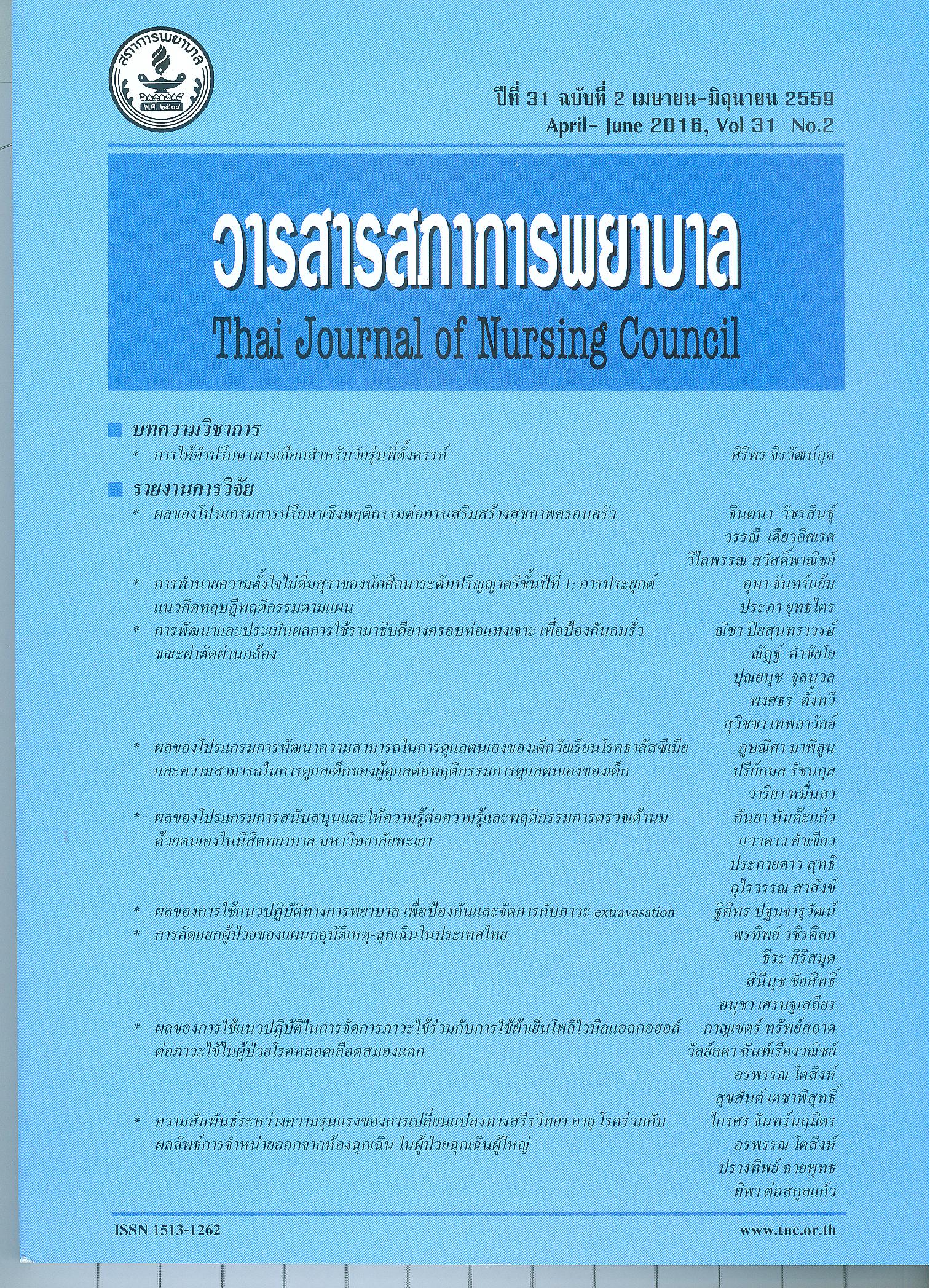ผลของการใช้แนวปฏิบัติในการจัดการภาวะไข้ร่วมกับการใช้ผ้าเย็นโพลีไวนิลแอลกอฮอล์ ต่อภาวะไข้ในผู้ป่วยโรคหลอดเลือดสมองแตก
คำสำคัญ:
แนวปฏิบัติ การจัดการภาวะไข้ การเช็ดตัวลดไข้ ผ้าโพลีไวนิลแอลกอฮอล์(polyvinyl alcohol towels) ผู้ป่วยโรคหลอดเลือดสมองแตก ผู้ป่วยชาย, application, fever management, tepid sponge method, polyvinyl alcohol towels, haemorrhagic stroke patients, male patientsบทคัดย่อ
วัตถุประสงค์ของการวิจัย: เพื่อประเมินผลของการใช้แนวปฏิบัติการจัดการภาวะไข้ร่วมกับการใช้ผ้าเย็นโพลีไวนิลแอลกอฮอล์ต่อภาวะไข้ในผู้ป่วยโรคหลอดเลือดสมองแตก เปรียบเทียบกับการพยาบาลลดไข้แบบปกติ
การออกแบบงานวิจัย: การวิจัยแบบ crossover clinical trial
วิธีดำเนินงานวิจัย: กลุ่มตัวอย่างเป็นผู้ป่วยที่ได้รับการวินิจฉัยว่ามีเลือดออกในสมองโดยไม่ได้เกิดจากอุบัติเหตุ รับการรักษาที่หอผู้ป่วยศัลยกรรมชาย โรงพยาบาลสวรรค์ประชารักษ์ จำนวน 44 ราย ใช้วิธีการศึกษากลุ่มเดียวแบบไขว้และสุ่มแบบง่ายให้กลุ่มตัวอย่างได้รับการลดไข้ทั้ง 2 วิธี จากนั้นวัดอุณหภูมิกายหลังเกิดไข้ทุก 1 ชั่วโมง 4 ครั้ง วิเคราะห์ข้อมูลโดยใช้สถิติทดสอบค่าทีการทดสอบของแมนวิทนีย์ ยู และการวิเคราะห์ความแปรปรวนแบบวัดซ้ำ
ผลการวิจัย: วิธีทดลองและวิธีควบคุมมีอุณหภูมิกายเฉลี่ยก่อนการทดลองเท่ากับ 39.38 (SD= .40) และ 39.35 องศาเซลเซียส (SD= .46) หลังการทดลองเท่ากับ 38.08 (SD = .57) และ 38.64 องศาเซลเซียส (SD = .59) วิธีทดลองมีอุณหภูมิกายลดลงหลังได้รับการลดไข้ตามแนวปฏิบัติอย่างมีนัยสำคัญทางสถิติ (p < .01) อุณหภูมิกายภายหลังได้รับการลดไข้ของวิธีทดลองน้อยกว่าวิธีควบคุมอย่างมีนัยสำคัญทางสถิติ (p < .01) ค่าเฉลี่ยระยะเวลาการเกิดไข้ครั้งต่อไปของวิธีทดลองและวิธีควบคุมเท่ากับ12.91 (SD = 11.31) และ 6.27 ชั่วโมง (SD = 5.28) ระยะเวลาการเกิดไข้ครั้งต่อไปของวิธีทดลองยาวนานกว่าวิธีควบคุมอย่างมีนัยสำคัญทางสถิติ (p < .01)
ข้อเสนอแนะ: พยาบาลควรนำแนวปฏิบัตินี้ไปใช้จัดการภาวะไข้ของผู้ป่วยโรคหลอดเลือดสมองแตกที่รับการรักษาในหอผู้ป่วยสามัญ
Objective: To assess and compare the efficacy of the fever management method applying polyvinyl alcohol towels with that of the regular tepid sponge method in haemorrhagic stroke patients.
Design: Crossover clinical trial.
Implementation: This study was conducted on a sample of 44 male patients having been diagnosed with non-traumatic haemorrhagic strokes and being treated at Sawan Pracharak Hospital’s Male Surgical Ward. The subjects were selected by means of random sampling and studied using a crossover clinical trial framework. The subjects were treated with both the towel method and the sponge method. After each fever, the subjects’ body temperatures were read four times at one-hour intervals. The data were analysed using the Mann-Whitney U Test and repeated measures ANOVA.
Results: The subjects’ average body temperatures were 39.38 C (SD = .40) before the towel method treatment and 39.35 C (SD = .46) before the sponge method treatment. After the treatment, their average body temperatures were 38.08 (SD = .57) and 38.64 (SD = .59), respectively. The results showed that the towel method induced a significant decrease in body temperature (p < .01), and, when compared with the sponge method, resulted in a significantly lower body temperature (p < .01). In addition, a significantly greater decrease in the average fever recurrence frequency was observed when patients were treated with the towel method (every 12.91 hours; SD = 11.31) than when they were treated with the sponge method (every 6.27 hours; SD = 5.28), a significant statistic difference of p < .01.
Recommendations: Based on this study, the use of polyvinyl alcohol towels is recommended for the purpose of reducing fever in haemorrhagic stroke patients being treated in intensive care units.
Downloads
เอกสารอ้างอิง
Rabinstein AA, Sandhu K. Non-infectious fever in the neurological intensive care unit: Incidence, causes and predictors. J Neurol Neurosurg Psychiatry 2007;(78):1278-80.
Diringer MN, Reaven NL, Funk SE, Uman GC. Elevated body temperature independently contributes to increased length of stay in neurologic intensive care unit patients. Crit Care Med 2004;32(7):1489-95.
Sung CY, Lee TH, Chu NS. Central hyperthermia in acute stroke. Eur Neurol 2009; (62):86-92.
Greer DM, Funk SE, Reaven NL, Ouzounelli M, Uman GC. Impact of fever on outcome in patients with stroke and neurologic injury. Am Heart J 2008;(39):3029-35.
Morgenstern LB, Hemphill JC, Anderson C, Becker K, Broderick JP, Connelly ES, et al. Guidelines for the management of spontaneous intracerebral hemorrhage. Stroke 2010; (41):2108-29.
Tømte Ø, Draegni T, Mangschau A, Jacobsen D, Auestad B, Sunde K. A comparison of intravascular and surface cooling techniques in comatose cardiac arrest survivors. Crit Care Med 2011;39(3):443-9.
Sureelak Sutchritpongsa, Boonying Manaboriboon, Chutintorn Jinda, &Chulathida chomchai. Added efficacy of paracatamol in tapid sponging for fever reduction. Siriraj Med J 2006;58(8):973-6. (in Thai).
Nipawan Samartkit. Comparison of the effects of sponging with wet-cloth wrapping and sponging with fanning on body temperature change in febrile head-injury patients. Master Thesis of nursing Science (Adult nursing). Faculty of Nursing. Mahidol University; 1989. (in Thai).
Kamada H, Ilayakawa T. Polyvinyl alcohol fibers, and nonwoven fabric comprising them. United State: US 7,892,992 B2; 2011.
Wassana Thanased. Cold pack blanket. J Health Sci 2012; 21:172-80. (in Thai).
Hunter JE,SchmidtFL. Method of Meta-Analysis. Newbury Park:Sage; 1990.
Duangpen Waewwanjit. The development and evaluation of clinical nursing practice guideline for fever management in patients with traumatic brain injury, Songklanagarind hospital. Master Thesis of nursing Science (Adult nursing). Faculty of Nursing. Prince of Songkla University; 2011. (in Thai).
Mendelow AD, Gregson BA, Fermandes HM, Murray GD, Teasdale GM, Hope DT, et al. Early surgery versus initial conservative treatment in patients with spontaneous supratentorial intracerebral haematomas in the international surgical trial in intracerebral haemorrhage (STICH): A randomized trial. Lancet 2005;(365):387-97.
Lemke DM. Sympathetic storming after severe traumatic brain injury. Crit Care 2007; 27(1):30-7.
Nakamura K. Central circuitries for body temperature regulation and fever. Am J Physiol Regul Integr Comp Physiol 2011;(301):R1207-28.
Mekjavic I, Eiken O. A physiological systems approach to human and mammalian thermoregulation. J Appl Physiol 2006;100:2065-72.
Faulds M, Meekings T. Temperature management in critical ill patients. Continuing Education in Anaesthesia, Crit Care 2013;(13):75-79.
Xu X, Werner J. A dynamic model of the human/clothing/environment-system. Appl Human Sci 1997;16(2):61-75.
Purssell E. Physical treatment of fever. Arch Dis Child 2000;(82):238-9.
Oddo M, Frangos S, Milby A, Chen I, Wilensky EM, Murtrie EM, et al. Induced normothermia attenuates cerebral metabolic distress in patients with aneurysmal subarachnoid hemorrhage and refractory fever. Stroke 2009;(40):1913-16.
Mayer SA, Kowalski RG, Presciutti M, Ostapkovich ND, Mcgann E, Fitzsimmons BF, et al. Clinical trial of a novel surface cooling system for fever control in neurocritical care patients. Crit Care Med 2014;32(12):2508-15.
Scaravilli V, Tinchero G, Citerio G. Fever management in SAH. Neurocrit Care 2011; (15):287-94.








